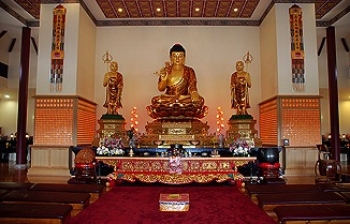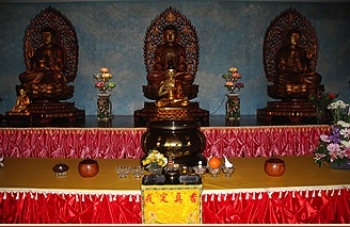Yun Yang Temple, a Chan temple located in Narre Warren North to the southeast of Melbourne, is now fully complete following more than 20 years of planning, cultivation, and construction.
“To build a Buddhist temple in the Southern Hemisphere is a wonderful and unique project,” said the temple’s abbot, the Chan master Venerable Ru Sun. “It needs to have great fortune and great causes and conditions to achieve such a grand task. The possibility of achieving our goal is due to all those supporters who have offered their help.”
Master Ru Sun was invited from Taiwan to teach Buddhism in Australia in 1993. Upon his acceptance, his disciples purchased a 32-acre plot of land bounded by a creek, old pine trees, and beautiful grassland with the view to constructing a temple. Yun Yang Temple was formally established in 1995, and has been fully operational ever since. Being far away from the hustle and bustle of city life and nestled within parkland and gardens, it provides a highly conducive environment for Dharma practice.
“To build a Buddhist temple in the Southern Hemisphere is a wonderful and unique project,” said the temple’s abbot, the Chan master Venerable Ru Sun. “It needs to have great fortune and great causes and conditions to achieve such a grand task. The possibility of achieving our goal is due to all those supporters who have offered their help.”
Master Ru Sun was invited from Taiwan to teach Buddhism in Australia in 1993. Upon his acceptance, his disciples purchased a 32-acre plot of land bounded by a creek, old pine trees, and beautiful grassland with the view to constructing a temple. Yun Yang Temple was formally established in 1995, and has been fully operational ever since. Being far away from the hustle and bustle of city life and nestled within parkland and gardens, it provides a highly conducive environment for Dharma practice.
Master Ru Sun has studied and practiced both Mahayana and Vajrayana Buddhism since childhood, and was ordained under the 40th Linji sect patriarch, the late master Bai Yun, at Qian Fo Shan monastery in Taiwan in 1974. He has also established three temples in Taiwan and two in Malaysia. Master Bai Yun, who is regarded at Yun Yang Temple as its grand-master, was born in mainland China in 1914. He moved to Taiwan in 1951, and established Qian Fo Shan Temple in 1974 at the request of his master, Xu Yin, as well as various other temples, learning centers, and foundations throughout Taiwan. He passed away in 2011 at the age of 97.
Initially, Yun Yang Temple consisted of a Chan practice temple converted from a pre-existing farmhouse. However, as the existing facilities were unable to meet the needs of the ever-increasing number of members and visitors, the temple’s committee decided to initiate a master plan for the cultivation of the land and the construction of the new temple buildings.
The temple now comprises: the main shrine building, with the main shrine upstairs and the reception and lecture hall downstairs; a multi-purpose hall (to the left); and the newly completed meditation hall (to the right). The three buildings are connected by covered corridors. In addition, there is a large Chan garden consisting of a white marble pagoda, a bridge, a pavilion, beautiful plantings, a lotus pond, a waterfall, and a 1.7-km walking track, which provides an excellent environment for spiritual cultivation. Other facilities on the grounds include the Tathagata Shrine, Guan Yin Shrine, and dining hall, a smaller meditation hall, a memorial hall, a library, a tea house, a gift shop, a “heavenly kings” hall, and two large car parks. Forty retreat huts have also been built.
“Our regular activities include daily morning and evening chanting and meditation practice,” shared founding committee member, Albert Chang. “Our Sunday activities include chanting, making offerings, lunch, meditation, and a Dharma talk. We also hold one-day retreats once a month and three-day, seven-day, and two-week short-term monkhood retreats annually.”
Initially, Yun Yang Temple consisted of a Chan practice temple converted from a pre-existing farmhouse. However, as the existing facilities were unable to meet the needs of the ever-increasing number of members and visitors, the temple’s committee decided to initiate a master plan for the cultivation of the land and the construction of the new temple buildings.
The temple now comprises: the main shrine building, with the main shrine upstairs and the reception and lecture hall downstairs; a multi-purpose hall (to the left); and the newly completed meditation hall (to the right). The three buildings are connected by covered corridors. In addition, there is a large Chan garden consisting of a white marble pagoda, a bridge, a pavilion, beautiful plantings, a lotus pond, a waterfall, and a 1.7-km walking track, which provides an excellent environment for spiritual cultivation. Other facilities on the grounds include the Tathagata Shrine, Guan Yin Shrine, and dining hall, a smaller meditation hall, a memorial hall, a library, a tea house, a gift shop, a “heavenly kings” hall, and two large car parks. Forty retreat huts have also been built.
“Our regular activities include daily morning and evening chanting and meditation practice,” shared founding committee member, Albert Chang. “Our Sunday activities include chanting, making offerings, lunch, meditation, and a Dharma talk. We also hold one-day retreats once a month and three-day, seven-day, and two-week short-term monkhood retreats annually.”
Yun Yang Temple is also very active within the community, and welcomes people from all backgrounds. On 28 October, the temple hosted 93 Casey Grammar School students as part of an interfaith tour, and on 11 November will do likewise for Berwick Primary School. These tours have taken place annually over the last seven years, and offer Dharma and meditation instruction as well as a tour of the grounds. The temple also holds an annual multicultural food fair.
















